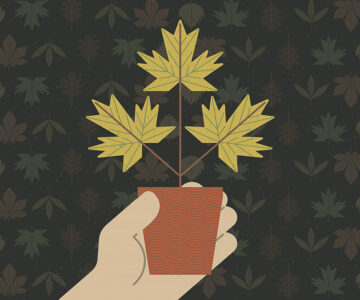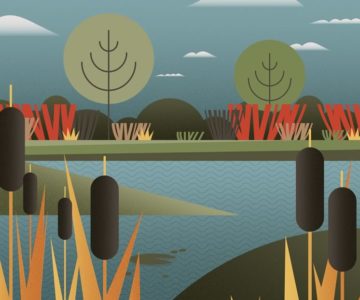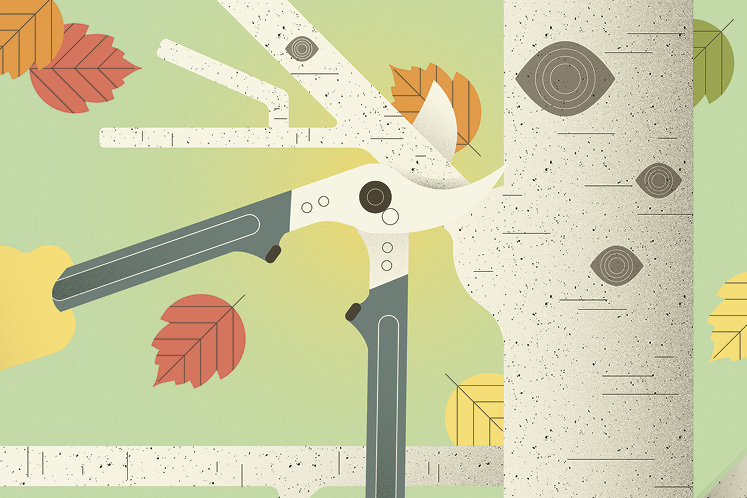Goodnight Trees, Goodnight Garden
The latest thinking in garden and lawn cleanup is all about doing a little less – which in turn does a lot more for pollinators, birds and your soil.
As the crisp fall air descends, the mind turns to all the yard work that needs doing before the snow flies. We tapped three local experts who shared some good news: Updated thinking involves a less-is-more approach. Where we once cut perennials back to the ground, for instance, we’re now being urged to leave them in place for ecological reasons. While your fall cleanup style remains a matter of personal taste, below are a few practices to consider as you pull on those work gloves.
Trees and shrubs
Resist the urge to over-prune, says Ryan Woodworth, garden care manager at Orangeville’s Tumber Landscape Design & Build. Most trees don’t need to be pruned until spring, except fruit trees and “bleeders,” such as maple or birch. (A spring prune will cause sap to run in all the wrong places.)
Limit your fall pruning to diseased, dead or overlapping, rubbing branches, and wait until the tree is dormant and has lost its leaves. Otherwise, Woodworth says, you’ll encourage new growth, which will be susceptible to disease and winter-kill. Pick a sharp tool – hand pruners or secateurs, loppers or a hand saw – that can easily handle the width of the branch. “Ideally you’re never tearing or pulling away bark,” he says. If you’re pruning a diseased plant, disinfect tools between plants, advises horticulturalist Elizabeth Hitchens of Hill N’ Dale Landscaping in Mulmur.
Where to prune? Go back to the last “y” in the branch and cut at the intersection of the two arms, which is where trees heal best, says Woodworth.
If you can’t reach a dangerous dead or dangling branch, colloquially known as “widow makers,” call an insured arborist to remove it, advises Hitchens. “Trees and branches have a bad rap for not falling in the direction you expect.” And lest you think a professional will be looking for more trees to fell, Hitchens adds that tree specialists are increasingly preservationist, loath to cut down a tree that has life in it.
Garden rethink
Many traditionalists cut perennials right back to the ground, but Caledon garden designer Matthew Gove says, “I’m more interested in moving away from that to a more eco-sensitive approach.” If his clients are willing, Gove leaves plants to wilt and decay. This returns nutrients to the soil and the micro-organisms that keep it healthy – and the plant litter provides winter homes and food for pollinator insects, and seeds and insects for birds. Hitchens says finches love coneflower seeds, for instance. If you must cut back, consider cutting hollow-stemmed plants, such as dill and big bluestem grass, to no less than a foot above the ground. Certain bees and other insects like to overwinter in them.
A messier, fading garden can be an adjustment for the eye, says Gove, but, “There’s beauty in decaying seedheads and the changing colours of grasses.”
Early fall can also be a great time to tuck in more plants – “Leave no open space for weeds,” Gove says. He cites a recent New York Times article in which American landscape designer Claudia West asserts, “Plants are the mulch.” Some of Gove’s fall planting picks are prairie dropseed (Sporobolus heterolepis) and late-blooming asters.
Be sure to water until the first freeze – even new evergreens, says Hitchens. “It’s considerably slowed down, but they’re still photosynthesizing. If the roots haven’t established, they can’t get moisture up to the needles and they’ll dry out.” And consider wrapping newbies in burlap until late winter. “It rather defeats the object of having an evergreen,” Hitchens admits, but she says it’s best for a year or two until the plant is established.
And don’t forget to plant early bulbs, she says. “There’s nothing nicer than seeing snowdrops and crocuses in the spring.”
Leaves v. lawn
Before you rake and bag all your leaves, consider keeping some on your lawn for the same reasons you left plants in the garden. While grey and pink snow mould can develop, keeping a single layer of leaves and chopping them with a lawn mower mitigates that risk, Woodworth says. Leaves you do remove can be used as mulch or added to compost.
The exception is any leaves marked by disease, such as black spot fungus found on Norway maples, apple trees and roses, says Hitchens. Remove them to break the cycle of infection, and keep them out of your gardens and compost. Hitchens takes them to the dump; others burn them.
What about that last lawn fertilizing? Woodworth advises against it, pointing to research out of the University of Guelph which says late fertilizer mostly runs off and what’s left encourages growth too late in the season. “Ideally, you’d also let your grass grow a bit taller. It’s healthy. It’s being weaned off its nutrients. It almost knows it’s time to go to bed.”
Related Stories

Tree Talk
Mar 20, 2023 | | Country Living 101No matter what your goal – adding shade and beauty to your property, attracting wildlife or fighting climate change – planting more trees is a good idea.

Happy Returns: Rural Tax Credits
Mar 29, 2022 | | Country Living 101As a country property owner you may be eligible to apply for one of three Ontario tax savings programs – and start your journey as a steward of the landscape.









